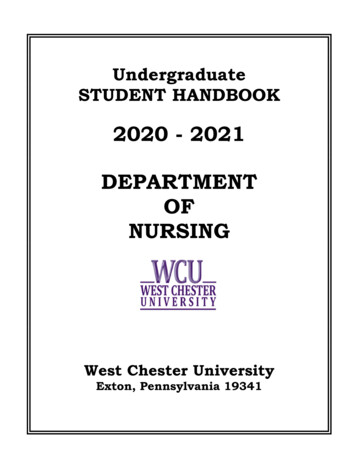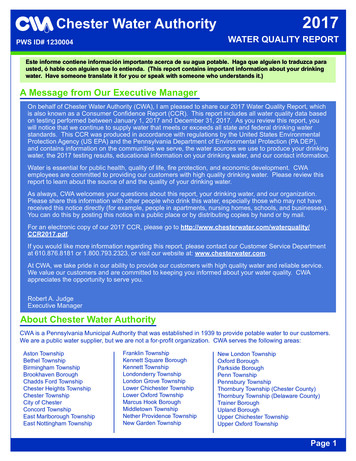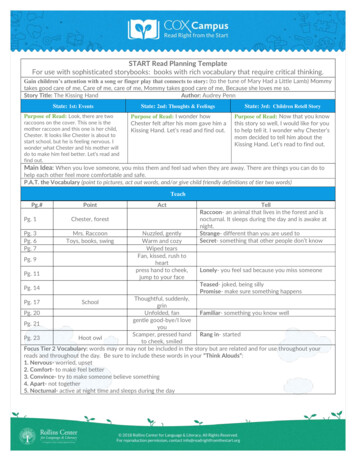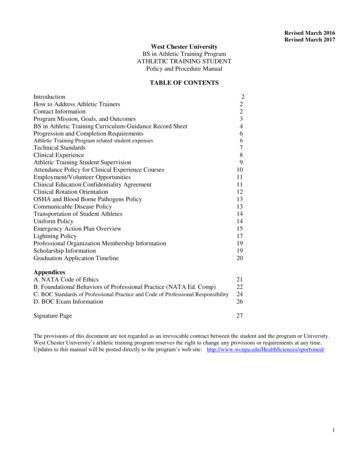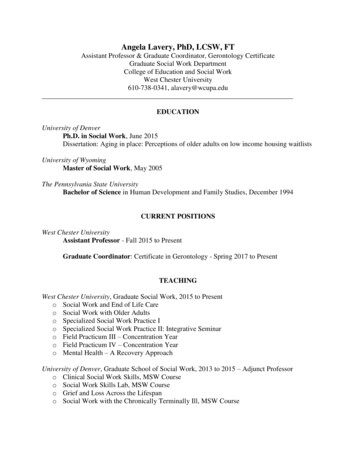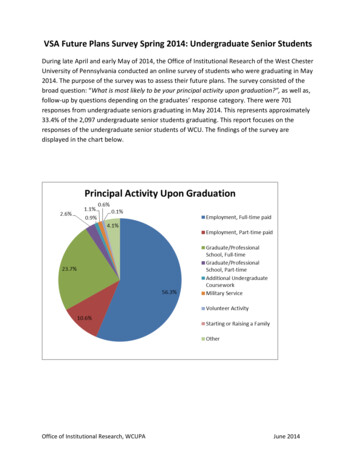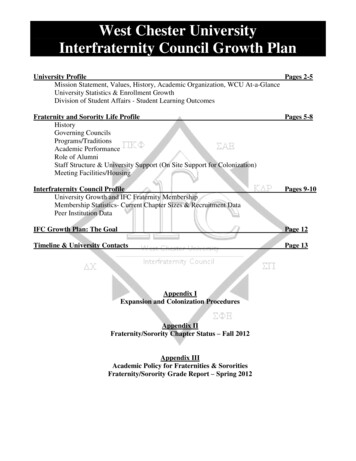
Transcription
West Chester UniversityInterfraternity Council Growth PlanUniversity ProfilePages 2-5Mission Statement, Values, History, Academic Organization, WCU At-a-GlanceUniversity Statistics & Enrollment GrowthDivision of Student Affairs - Student Learning OutcomesFraternity and Sorority Life ProfileHistoryGoverning CouncilsPrograms/TraditionsAcademic PerformanceRole of AlumniStaff Structure & University Support (On Site Support for Colonization)Meeting Facilities/HousingPages 5-8Interfraternity Council ProfileUniversity Growth and IFC Fraternity MembershipMembership Statistics- Current Chapter Sizes & Recruitment DataPeer Institution DataPages 9-10IFC Growth Plan: The GoalPage 12Timeline & University ContactsPage 13Appendix IExpansion and Colonization ProceduresAppendix IIFraternity/Sorority Chapter Status – Fall 2012Appendix IIIAcademic Policy for Fraternities & SororitiesFraternity/Sorority Grade Report – Spring 2012
UNIVERSITY PROFILEMission StatementWest Chester University, a member of the Pennsylvania State System of Higher Education, is a public, regional,comprehensive institution committed to providing access and offering high-quality undergraduate education,select post-baccalaureate and graduate programs, and a variety of educational and cultural resources for itsstudents, alumni, and citizens of southeastern Pennsylvania.Values StatementWest Chester University is committed to attracting, enrolling, and graduating quality students from a wide varietyof educational, cultural, and economic backgrounds. This endeavor requires the University to attract and retainhighly qualified faculty and staff and to provide each member of the University community with learning andleadership development opportunities. To this end, the University supports and encourages programs whichbenefit all people and which seek to eradicate discrimination and injustice. We treasure what we believe to be thehighest principles of American society: the worth and uniqueness of each individual, the belief that success is tobe earned by individual effort put forth in an environment founded on equality of opportunity, and theappreciation of the ideal of an inclusive society.We believe that it is incumbent upon all members of our community - staff, students, faculty and administrators to conduct themselves with civility toward one another at all times. We value the special talents and contributionsof each member of our community. We further affirm the worth and dignity of each member and the sharedresponsibility of all to treat each other as individuals, with respect and courtesy.As a university owned by the citizens of Pennsylvania, we value our mission to provide the best educationalopportunities possible which will enable the University community to successfully address the concerns of aglobal society. To this end, West Chester University seeks to provide diligent advising for students and to focuson teaching students to think clearly and critically, to make logical and ethical judgments, and to communicateeffectively with others.West Chester University's community strongly supports the principles of academic integrity and academicresponsibility, viewing both as the province of every member of the campus community. We hold the highestesteem for teaching directed toward student learning and affirm that mastery of content as well as mastery ofteaching skills necessary to communicate such content are paramount.This values statement is intended to be a living document which will serve West Chester University as it changesand evolves in the coming years.Vision StatementWest Chester University will be a national model for excellence for public regional comprehensive universitiesand especially noted for: Undergraduate programs that actively engage students in connecting the life of the mind to the world inwhich they live and work. The responsiveness of its graduate and post-baccalaureate programs to regional needs. Its focus on providing lifelong-learning, technical, and applied skills essential to graduates’ success nowand in the future. A commitment by faculty, staff, and administrators to provide access and to serve effectively theeducational needs of a diverse student body. Its role as a leading educational and cultural resource and partner in fostering the economic, social, andcultural vitality of southeastern Pennsylvania.2
History of West Chester UniversityAlthough its founding year is 1871, the University in fact has deeper roots tracing from West Chester Academy, aprivate, state-aided school that existed from 1812 to 1869. The academy enjoyed strong support from the highlyintellectual Chester County Cabinet of the Natural Sciences of the pre-Civil War decades. It was recognized asone of Pennsylvania’s leading preparatory schools, and its experience in teacher training laid the groundwork forthe normal school years that were to follow.As the state began to take increasing responsibility for public education, the academy was transformed into WestChester Normal School, still privately owned but state certified. The normal school admitted its first class,consisting of 160 students, on September 25, 1871. In 1913, West Chester became the first of the normal schoolsto be owned outright by the Commonwealth.West Chester became West Chester State Teachers College in 1927 when Pennsylvania initiated a four-yearprogram of teacher education. In 1960, as the Commonwealth paved the way for liberal arts programs in itscollege system, West Chester was renamed West Chester State College, and two years later introduced the liberalarts program that turned the one-time academy into a comprehensive college.In recognition of the historic merit of the campus, in 1981 the West Chester State College Quadrangle HistoricDistrict was placed on the National Register of Historic Places. The buildings included in this historic district arePhilips Memorial Building, Ruby Jones Hall, Recitation Hall, and the Old Library. Except for Philips, thesebuildings are all constructed of native Chester County serpentine stone.West Chester State achieved another major milestone with passage of the State System of Higher Education bill.West Chester became one of the 14 universities in the State System of Higher Education on July 1, 1983. Alongwith its new name – West Chester University of Pennsylvania of the State System of Higher Education – theinstitution acquired a new system of governance and the opportunity to expand its degree programs.WCU At-a-GlanceEstablished:1871President:Greg R. WeisensteinStudents:15,100 (2011-2012 Academic Year)Alumni:75,000Accreditation: Middle States Association of Colleges and SchoolsPrograms:Baccalaureate – 80Master’s – 70Athletics:24 varsity sports (largest Division II Athletic Program in the Country)Official colors: Purple and goldConference:Mascot: RamNCAA Division II, Pennsylvania State Athletic Conference (PSAC)Campus Setting: Suburban, 405 acresStudent/Faculty Ratio: 18/1Endowment: 12.3 million% of Alumni Giving: 6%Admissions Selectivity Rating – 823
University Statistics & Enrollment GrowthUniversity Statistics for past five years:Fall 2006Fall 2007Fall 2008Fall 2009Fall 2010Fall 2011(1) All Student enrollment12,88213,22313,62114,21114,49215,100(2) FTE-U enrollment*9,7239,97610,34210,84411,14011,635(3) Number of FTU men4,1584,3324,5064,7984,9695,282(4) Percentage living on campus(First year %(92.2%)41%(92%)(5) Average HS GPA3.323.353.323.323.483.56(6) Top 10% of HS ClassTop 25% of HS %42.6%(7) 6 Year Graduation Rate**59%59.1%63.2%63.6%65.1%65.4%(8) Percentage Out-of-State17%15.4%14.5%15.4%16.49%16%*FTE-U Full time enrolled undergraduate**Surpass the national average for similar institutions by 13.02West Chester University: Vital Stats For the fourth year in a row, Kiplinger’s Personal Finance has rated WCU among the 100 best values inAmerican Public Higher Education The fourth largest university in the Philadelphia region. One of the 14 universities that comprise Pennsylvania's State System of Higher Education. A public, regional, comprehensive institution, founded in 1871 as an institute for teacher preparation. Inaddition to education, which is the most popular major today, music instruction has been part of theschool's curriculum since its founding. Organized into five Colleges: Arts and Sciences; Business and Public Affairs; Education; HealthSciences; and Visual and Performing Arts, plus the Office of Graduate Studies. Currently offers more than 80 undergraduate and 70 master's degree programs taught by 563 full-time and243 part-time faculty. (Fall 2010) Students are drawn primarily from Pennsylvania, Delaware, New Jersey and Maryland. In total, studentscome from 26 different states and 64 different countries. The undergraduate student body is 60% female, 40% male and 15% students of color. (Fall 2010) The University supports 24 men's and women's athletic teams. The "golden ram" is the University's official mascot. A bronze statue of the ram stands at the corner ofWest Rosedale Ave. and Church St. in front of the University's Old Library building.4
Division of Student Affairs - Student Learning OutcomesThe Division of Student Affairs is committed to the philosophies outlined in the University and Student AffairsMission and Values Statements. Inherent in the Division of Student Affairs Core Values and Assumptions is thatstudents, throughout their experience at WCU, will enhance their personal adult identity. (These statements can befound at www.wcupa.edu/ services/stu)In combination with the student's academic program (including the general education component), the cocurricular program offered through the Division of Student Affairs is directed at producing graduates who:1. Use critical, reflective and analytical thinking in decision-making and reasoning;2. Respond thoughtfully to social responsibly and diversity;3. Exhibit a commitment to civic engagement and an awareness of global responsibility;4. Demonstrate a sensibility, understanding, and perspective of lifelong leadership;5. Develop, enhance, clarify, and communicate one's personal and professional values, ethics, and integrity;6. Display the ability to integrate and apply knowledge, ideas, and experiences to one's daily life;7. Achieve academic success and persist to graduation.FRATERNITY AND SORORITY LIFE PROFILEHistoryOn September 27, 1967, The Board of Trustees approved the recommendations of the IntracollegiateGovernmental Association (SGA) and Student Affairs Division to adopt the policy to permit the organization ofsocial fraternities and sororities on the West Chester State College campus. The very same semester, sixfraternities began seeking members: Lambda Chi Alpha, Sigma Tau Gamma, Zeta Beta Tau, Tau Kappa Epsilon,Theta Chi and Pi Lambda Phi.Two National Sororities began: Delta Zeta (January 11, 1969), and Sigma Delta Tau (April 25, 1969).Concurrently, many local sororities that already existed took steps to associate with Inter/National Sororities.Kappa Theta became Alpha Omicron Pi (March 1968), Delta Sigma Tau became Alpha Sigma Alpha (November15, 1969), Sigma Kappa Rho became Alpha Sigma Tau (November 4, 1969), Sigma Chi Omega became Zeta TauAlpha (April 11, 1970), Delta Psi Omega became Alpha Xi Delta (December 6, 1970), and Alpha Phi Sigmabecame Alpha Phi (April 17, 1971). Local sororities that decided not to affiliate would eventually not be able tosustain membership: Delta Phi Iota, Eta Iota Rho, Lambda Delta Chi, and Phi Sigma Rho.On December 19, 1969, Alpha Phi Alpha Fraternity, Inc. became the first National Pan-Hellenic Council memberorganization established at WCU. West Chester holds the distinction of a few predominantly white colleges anduniversities to establish a historically African American fraternity at the same time as other chapters. A strongpresence of NPHC fraternities and sororities has sustained throughout the years, beginning with the establishmentof Alpha Kappa Alpha Sorority, Inc. (December 8, 1973).In the early part of the 1970’s, the fraternity and sorority community would undergo a time of building, hiring afull time Greek Life Professional and creating their governing councils. Fraternities and sororities that could notsustain membership had to ultimately close during the first half of the decade (Zeta Beta Tau, Sigma Tau Gamma,Pi Lambda Phi, Sigma Delta Tau, Alpha Omicron Pi, Alpha Sigma Alpha). And, as Sigma Phi Epsilonestablished on December 1, 1979, Lambda Chi Alpha closed shortly after in 1980.In the early 1980’s, the NPHC community welcomed Phi Beta Sigma Fraternity Inc. March 25, 1977), KappaAlpha Psi Fraternity, Inc. (Established April 14, 1980), Zeta Phi Beta Sorority Inc. (October 20, 1981), andOmega Psi Phi Fraternity, Inc. (1983). And the Interfraternity Council community added Alpha Chi Rho(October 29, 1983), Sigma Pi (February 4, 1984).The latter part of the 1980’s brought about another boom in expansion of new chapters for the InterfraternityCouncil: Phi Kappa Sigma (May 1, 1987), Phi Delta Theta (January 16, 1988), Pi Kappa Phi (January 28, 1989),Kappa Delta Rho (December 8, 1989). NPHC added the two more of the Divine Nine: Delta Sigma ThetaSorority, Inc. (April 9, 1989) and Sigma Gamma Rho Sorority, Inc. (April 13, 1991). The Panhellenic Council5
would add the first new organizations since establishing ten years earlier with Delta Phi Epsilon (April 16,1989) and Phi Sigma Sigma (December 9, 1990).The 1990’s were a period of stabilization for the community. In addition to Delta Chi joining the InterfraternityCouncil, (April 27, 1996), WCU joined many other Universities in the northeast region of the country to see aninflux of culturally based fraternities and sororities. The first historically Latin organizations were established:Lambda Theta Phi Fraternity (February 1, 1993) and Lambda Theta Alpha Sorority (April 10, 1994).At the turn of the 21st century, Panhellenic welcomed Phi Mu (April 15, 2000), and the newly formed ―Black andLatino Greek Council‖ recognized its second Latin sorority, Chi Upsilon Sigma (December 2, 2001).The Interfraternity Council also added more chapters with Beta Theta Pi (February 2, 2002) and Sigma AlphaEpsilon (April 4, 2004). Lambda Alpha Upsilon Latin Fraternity was established on April 21, 2007. The newestInterfraternity Council chapter to join the community was Delta Chi on November 6, 2010. Mu Sigma Upsilonbecame the first multicultural sorority to join the community, founded on April 13, 2008. On September 27,2012, BLGC welcomed the colonies of Sigma Lambda Gamma Sorority, Inc. and Sigma Lambda Beta Fraternity,Inc.As of October 2012, WCU hosts 26 inter/national fraternities and sororities, with more than 1000 active membersand a combined membership of 6,000 alumni. While the names of the chapters look a little different throughoutthe years, the fraternity and sorority community has seen a steady and healthy increase. While there has been anincrease collectively, the number does not match the rise in enrollment of the University, thus creating a need toselect inter/national organizations that have a high level of local and national support to create a sustainablepresence on campus.The entire fraternity and sorority community is committed to sustainable growth. In addition to the InterfraternityCouncil long term expansion effort, the Panhellenic Council will participate in the National PanhellenicConference Extension process during the 2012-2013 academic year, with a new sorority to establish in the fall of2013. The Black and Latino Greek Council will also undergo a comprehensive review of its recognition processby adopting a plan that will encourage membership growth for current member organizations and theestablishment of new chapters that meet the need for WCU students seeking membership in culturally basedfraternities and sororities.*italicized chapters are current active chapters at WCUGoverning CouncilsInterfraternity CouncilIn 2012, the Interfraternity Council will consider new policies and standards relating to academics, judicialproceedings, social policies, philanthropic programming, recruitment, and finances. Restructuring the officersserving on the IFC Executive Board will assist the council’s goal to have all policies and standards in place forbefore any new organization will join. This is a period of restructuring and growth for the IFC and it is seekinginter/national organizations that will partner with IFC’s commitment to where it wants to be in the next ten years.Funding:Average Annual Student Government Association Allocation: 9,000.00Average Revenue from member organization dues: 5,000.00Black & Latino Greek CouncilThe 11 historically African and Latino American Greek letter organizations at West Chester University aremembers of the BLGC. The 9 member elected executive committee serves as an advocate for the over 75 BLGCmembers, coordinates events and activities for all chapters and coordinates the programs and services of memberorganizations.Funding:Average Annual Student Government Association Allocation: 5,500.006
Panhellenic CouncilNine elected executive officers and other appointed leadership positions assist the Panhellenic Council inproviding programs and services to the 8 sororities. The Panhellenic Council actively promotes Greek life andwomen's issues in the campus community, coordinates the activities and programs of member organizations, andplans major events and activities for over 700 Greek women. The Fall 2012 Recruitment process boasted thelargest number of new members in WCU history, supporting its current need to establish a new chapter in the Fallof 2013. The Panhellenic Council is the largest women’s organization at West Chester University.Funding:Average Annual Student Government Association Allocation: 8,500.00Average Revenue from member organization dues: 12,000.00Programs/TraditionsInter-Greek CouncilAll recognized fraternities and sororities comprise this Greek programming council. Responsible for creating andsponsoring Inter-Greek programming, this council coordinates such events as Greek Week, Homecoming, MLKDay of Service, etc. The council executive board is comprised of nine student leaders elected by the community.Funding:Average Annual Student Government Association Allocation: 18,000.00Programs for Fraternity and Sorority Life include, but are not limited to: Community Service Block Cleanups Camp Dreamcatcher Community Wide Philanthropy (raising 25,000 per year) 20 Scholarships to the Undergraduate Fraternity Institute each year Presidential Roundtable meetings (monthly) Spring 2013 – First Annual Fraternity and Sorority Leadership Retreat for all the new fraternity and sororityexecutive officers and one emerging leader per chapter Greek Week – include Greek Games, Penny Wars, Canstruction, Stroll/Step Competition Spring 2013 - Association of Fraternal Leadership and Values Conference- Council Officers attend thisnational conference Homecoming Events – parade and court Fraternity and Sorority Awards- honors in the eight standards areas and outstanding male/female leader ofthe year, new member of the year Fall 2012 – newly chartered chapter of Fraternal Values Society Departmental Partnerships – Women’s Center, Career CenterAcademic PerformanceIn the Spring of 2011, the Office for Fraternity and Sorority Life updated the Academic Policy for fraternities andsororities at WCU. See Appendix IV for this policy along with the Spring 2012 Grade Report.As the academic standard of the institution rose, the GPA of the undergraduate men did as well. In the Fall of2008, the average GPA of the undergraduate members of IFC chapters passed the average GPA for non members.Historical IFC Academic Data:IFC AverageFall 2006Fall 2007Fall 2008Fall 2009Fall 2010Fall 20112.792.772.852.912.912.977Undergraduate MenAverage2.792.82.842.842.842.85
Role of Alumni/aeWCU fraternity and sorority alumni/ae are a very integral and active part of fraternal life. It is an expectation thateach fraternity and sorority chapter have an alumni advisory board in order to help guide the undergraduatechapter. In addition, the Office of Fraternity and Sorority Life provides training and development to the advisorson an on-going basis. One of the major initiatives for the 2013-2014 academic year is the establishment of aFraternity & Sorority Alumni Board.Staff Structure and University SupportWCU has had a long and positive relationship with fraternities and sororities. The University acknowledges thatthe fraternity and sorority community comprises an integral part of the campus community. It sees theseorganizations as a vital and important component of the co-curricular experience for undergraduate students. Italso recognizes that membership can be an educational and valuable part of the growth and development of ourstudents’ lives.With the addition of the Assistant Director for Student Involvement & Greek Life, the Division of Student Affairscontinues to prove its support. Professional staff meets with each chapter President on a regular basis in order tocreate a working relationship and avenue for communication. The chapters are held to community standardswhich are outlined in the ―5 Star‖ Standards Program which is currently being re-developed and will launch inFall of 2013.On-Site Support for Colonization:The Interfraternity Council will sponsor the following for (1) Fraternity Staff member1) On-Campus Housing option (if available)2) Meal Plan3) Parking4) Shared office space with undergraduate student leadersMeeting Facilities/Housing The governing councils share office space in the student organization office suite in the student union. Currently, meeting facilities for Fraternity and Sorority Life are at the discretion of the organization.Essentially all WCU buildings have space which can be reserved for many different purposes. At this time, WCU does not recognize any official fraternity/sorority housing. There are two fraternitiesthat live in Housing Corporation run facilities off campus. Housing for the WCU Fraternity and SororityCommunity will continue to b a topic of discussion for several years, but there are no plans to beginanything formal. The WCU Campus is alcohol-free. Consequently, any fraternity that supports an alcohol free housinginitiative would be a great fit for the community.8
INTERFRATERNITY COUNCIL PROFILEUniversity Growth & IFC fraternity membership– past, present and future:The enrollment of full time undergraduate men continues to increase at a rate that is not consistent with thegrowth rate of the current fraternities. Most peer institutions maintain a steady 10% of the student body asfraternity and sorority members. Currently, WCU only has 5.3% of the male population involved in an IFCfraternity.According to the Office for Institutional Research, WCU enrollment for the 2011-2012 academic year was 15,100students (11,635 undergraduate) with 45%, or 5,282 of those full-time undergraduate men. If WCU continues togrow at the same rate, projections for enrollment could reach 6,700 full-time undergraduate men.Year200620072008200920102011WCU FTE-UMale Population4,1584,3324,5064,7984,9695,282% of Males inIFC Fraternity8.2%6.8%7.3%7.5%7.8%5.3%IFC Population# of menAve. Chapter Size339442984232941359453904828240Growth Projections if FTE-U Male Population remains the 6.4%7%8%9%10%3363694234755285662707988Growth Projections if FTE-U Male Population increases:6,7006,7006,7005.3%6%8%355402536596789 Average chapter size has remained constant since 2006 with approximately 40-45 men in 8 fraternities in2006 and is now 56 with 6 fraternities in 2012. From 2006-2011, the percentage of men in an IFC Fraternity has decreased by 25%. Enrollment statistics indicate that IFC will become an insignificant factor on campus should the currentmakeup (6 groups with total of 336 men) remain unchanged. This projection opposes the current Division of Student Affairs Strategic Plan Priority #9 to increaseengagement in student organizations.As of October 1, 2012, WCU IFC Community is a collective body of 336 men (6 chapters with the averagechapter size at around 56), which is only 6.4% of our current full-time undergraduate male population. The IFCgoal is to maintain average chapter size at about 45-50 men. In order to meet that average chapter size, whilematching the undergraduate male population growth, we must increase the number of chapters than men have theopportunity to join.9
The well-known research indicates that on each college campus, the men and women that join fraternities andsororities are broken down into three categories: 10% always joiners, 80% maybe joiners, and 10% never joiners.With that in mind, WCU’s IFC Community is able to support a minimum of over 500 men in the next 5 years.Simply stated, growth is needed if the IFC Community is to keep up with enrollment trends.WCU TotalPopulationWCU FTEUndergraduate“Always Joiners”IFC PopulationYearTotalMenTotalMen#% of men in theundergrad population10 % of men in theundergrad 8224,6689,7234,1583398.1%415201115,1005,99611, 6355,2822825.3 %528Membership StatisticsChapters on campus with dates of establishment and current chapter size:Chapters on CampusDelta ChiKappa Delta RhoPi Kappa PhiSigma Alpha Epsilon*Sigma Phi EpsilonSigma Pi*Date of EstablishmentRe-chartered 201019891989200419791984Fall 2012 Chapter Size445071505764*experienced membership review process at some point in the last 2 yearsMembership recruitment data: (Total # of new members—combined semesters)Chapters on Campus Fall 2012 2011-2012 2010-2011 2009-2010 2008-2009 2007-2008 2006-2007Beta Theta Pi*closed1416231514Chapter re-established in20081210Delta Chi122010222Kappa Delta Rho132371612Pi Kappa Phi202521111522131616151821Phi Kappa SigmaclosedSigma Alpha Epsilon*245191519914Sigma Phi Epsilon9241921161110212714201217*experienced membership review process during in Spring 2011 or Fall 201123Sigma Pi*10
Peer InstitutionsThe following peer institutions (within Pennsylvania) have less total number of students and more IFC chapters:PASSHE SchoolsWest iana UniversityMillersvilleEast StroudsburghClarionLock HavenMansfieldCheyneyKutztownSlippery RockTotal 11434001200102838712IFC687871245352565Other similar institutionsSimilar InstitutionsTotal EnrollmentIFCWestern Illinois13,60011Arkansas State13,2397Stephen F. Austin State12,90317Eastern Illinois12,17913Central Missouri StateRadford9,466109,37010Longwood University4,5007Towson20,00010Sam Houston State17,6008Georgia Southern17,52517Appalachian State17,3449University of Central Oklahoma17,1016Saint Cloud State17,0005Eastern Kentucky16,51510California State- Hayward14,8006Youngstown State14,0005University of Northern Iowa13,1684Austin Peay State10,188611
INTERFRATERNITY COUNCIL GROWTH PLAN: THE GOALThe Goal:It is the goal of the Interfraternity Council to add 3 chapters in the next 5-6 years in order to maintain an averagechapter size of around 50 men. This goal allows for a vision of the IFC to be a collective body of more than 500men and 8% of our full time undergraduate men.Looking at the number of chapters that have opened and closed in the past twenty years, it is the desire of theInterfraternity Council to establish chapters not based on local interest group desires – rather, standards and valuesset by an inter/national organization.Rate of Growth:In order to maintain a healthy rate of growth, it is the intention of the IFC to gather data and assess the currentsaturation of available potential members after each colonization process. This expansion process will includeidentifying the next three chapters to come to WCU’s campus – but will allow for the inter/national organizationto identify the time period in which it wants to establish a chapter.For example:Option A:Fall 2013May 2014Fall 2014Option B:Fall 2013May 2014Fall 2014Colonization of IFC Group #1Assessment and EvaluationColonization of IFC Group #2Fall 2015Colonization of IFC Group #1Assessment and EvaluationNo Group StartsContinued monitoringColonization of IFC Group #2Assessment and Evaluation:Continuing to the next group in line is dependent upon the continued success of existing groups, as well as thesuccess and stabilization of the new group. Criteria to measure ―success‖ will be based on NIC Standards anddetermined in partnership with the inter/national organization.For existing groups, success can be determined by looking at the following: A majority of chapters maintain or increase their current chapter size and consider the implications ofcontinued growth vs. replacement of membership. Continued academic success: an all-fraternity GPA above the all-men’s average.For new groups, the IFC Expansion Policy (Appendix II) describes a comprehensive set of expectations that eachcolony must fulfill—the purpose of this process is to create a system of accountability for the success of each newgroup.Timeline:The IFC will select a total of five organizations (3 finalists and 2 alternates) – and will rank the order in whatpreference to give the national organization the chance to select the semester that best fits their national expansiontimeline. Chapter #1 will have the first choice to select what semester it wants to expand, #2 will have secondchoice and #3 will have third choice. A total of ten (10) semesters are available between Fall 2013-Spring 2018)Chapter Closures:If an IFC chapter should close between now and the Fall of 2017, the two alternate chapters will be notified andinvited to colonized at the next available semester.12
TIMELINEOctober 25, 2012IFC votes on Expansi
This values statement is intended to be a living document which will serve West Chester University as it changes . West Chester State achieved another major milestone with passage of the State System of Higher Education bill. West Chester became one of the 14 universities in the State System of Higher Education on July 1, 1983. Along


